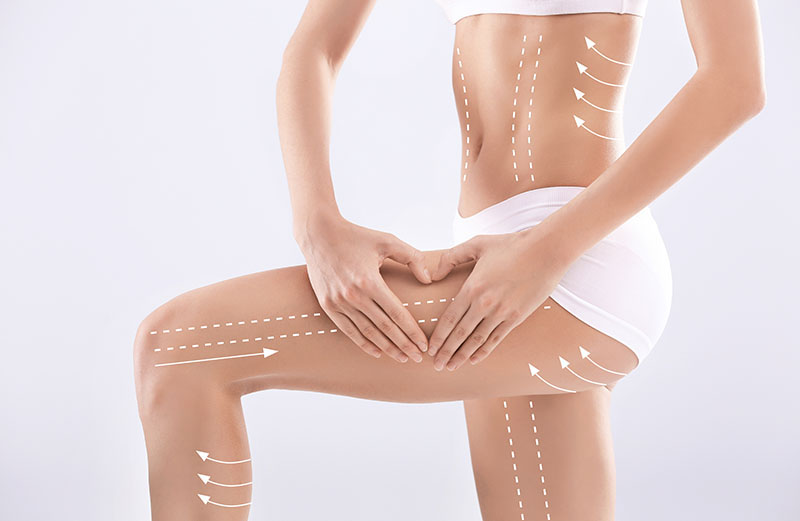Published on Veröffentlicht am September 4, 2025
News

Resolving adhesions after liposuction: Causes, symptoms, and effective measures
No time? Here are the 3 key takeaways:
- Frequency and causes: Up to 30% of patients develop noticeable adhesions after liposuction – most often due to insufficient mobilization, inadequate lymphatic drainage, or improper use of compression garments during the healing phase.
- Duration and treatment methods: Mild hardenings often resolve within 6–12 weeks; for persistent fibrosis, targeted therapies such as manual lymphatic drainage, ultrasound, endermology – or in severe cases, modern laser lipolysis – can be effective.
- Quick relief for patients: Scheduling 2–3 lymphatic drainage sessions per week after surgery, consistently wearing compression garments (4–8 weeks), and introducing a fascia roller from week 4–6 have been shown to noticeably improve outcomes and shorten recovery time.
When dimples remain: How to properly treat adhesions after liposuction
Adhesions after liposuction are not uncommon – and for many patients, they can be a distressing issue. They often present as hardenings, dimpling, sensations of tightness, or even pain in the treated area. What makes them particularly frustrating is when, despite undergoing an aesthetic procedure, the skin does not appear smooth and even. But what exactly causes these adhesions? Why do they occur – and how can they be treated effectively?
In this article, you’ll find a comprehensive overview of the causes, symptoms, timeline of development, and the most effective methods for treating adhesions after liposuction.

Causes – How do adhesions develop after liposuction?
After the procedure, the body initiates its natural healing process. During this phase, minor internal injuries, fluid retention, and tissue remodeling can occur. In many cases, so-called fascial adhesions, scar traction, or post-traumatic fibrosis develop when this healing process is uneven or disrupted.
Common causes include:
- delayed or insufficient mobilization
- lack of or inadequate manual lymphatic drainage
- poorly fitting or prematurely discontinued compression garments
- genetic predisposition to connective tissue hardening
- overly intense physical activity during the early healing phase
The quality of aftercare should not be underestimated: many patients are unaware of how crucial the weeks following surgery are for achieving the final result.
Symptoms – How can adhesions be identified?
Adhesions are not always immediately visible or noticeable. They often appear only weeks or even months after surgery. The most common signs include:
- hardenings under the skin, often palpable like small nodules
- dimpling or irregular contours
- sensations of tightness, pressure, or mild burning
- asymmetrical skin appearance
- restricted mobility, especially in larger areas such as the abdomen or thighs
- pain or tenderness when lying down or upon touch
Acting early is worthwhile!
The earlier these changes are detected and treated, the better the chances for complete resolution.
Treatment – Which methods effectively resolve adhesions after liposuction?
The good news: in many cases, adhesions can be successfully and permanently treated – especially with early intervention. A combination of professional aftercare and proactive self-care is particularly effective.
1. Manual lymphatic drainage
This gentle massage technique is one of the first measures after surgery. It promotes the removal of excess fluid, reduces swelling, and can help prevent adhesions from forming in the early stages.
Recommendation: 2–3 sessions per week during the first 2–4 weeks after surgery.
2. Fascia massage & foam roller
Targeted fascia treatments, either manually or with a foam roller, improve circulation and loosen tight connective tissue. It is important to build up gradually – depending on the stage of healing and approval from the treating physician.
Caution: Do not start too early – usually only from week 4–6.
3. Ultrasound or shockwave therapy
Technical procedures such as ultrasound therapy or extracorporeal shockwave therapy (ESWT) work deep into the tissue and help dissolve stubborn fibrosis. They stimulate cell regeneration and support even blood circulation in the treated area.
Best suited for larger or long-standing adhesions.
4. Laser lipolysis – Your option for stubborn adhesions
Adhesions that cannot be resolved through massage, lymphatic drainage, or fascia rolling may significantly affect the surgical outcome. Laser lipolysis is a modern, minimally invasive technique designed to specifically loosen hardened tissue while simultaneously smoothing the skin’s appearance.
- The thermal effect releases adhesions and stimulates collagen production
- Performed on an outpatient basis, virtually painless, with a short recovery time
- Suitable for chronic fibrosis, palpable nodules, or dimpling
- Additional skin-tightening effect as a bonus
Would you like to know if laser lipolysis is the right option for your case? Contact us – we’ll provide you with honest and personalized advice.
Tel: +49 89 255 422 50Schedule a consultation appointment
5. Endermologie (vacuum massage)
Endermology is an instrumental connective tissue massage in which the skin is lifted and mechanically stimulated using vacuum technology. This method enhances microcirculation and helps release hardened tissue.
Especially effective when combined with lymphatic drainage or ultrasound.
6. Scar care & topical products
Special scar gels, silicone creams, or enzyme-based preparations improve skin elasticity, reduce sensations of tightness, and support regeneration. Herbal ingredients such as arnica, panthenol, or calendula have also proven beneficial.
Consistent application is key to treatment success.
7. Kinesio taping & mobilization
Kinesio tapes, applied specifically along the affected structures, support lymphatic circulation and relieve tissue stress. Complementary mobilization therapy with an experienced physiotherapist may also be valuable.
Particularly helpful after extensive procedures or in cases of restricted mobility.
Patience required – How your tissue
develops after liposuction

After liposuction, the body undergoes a complex regeneration process that unfolds over several weeks to months. In the first 2–4 weeks, swelling, fluid retention, and temporary irregularities are completely normal. Between weeks 4 and 8, the connective tissue gradually reorganizes – this is also the period when adhesions or fibrosis may become noticeable. From the third month onward, the skin begins to settle more evenly, and with the right therapies, adhesions can often be minimized or resolved entirely.
It is important to understand that the healing process takes time. Even with optimal aftercare, the final result of liposuction usually only becomes visible after 6–12 months. With patience, consistent aftercare, and the right supportive treatments, most patients achieve a smoother, more harmonious skin texture.
Laser lipolysis – Your option for stubborn adhesions
Adhesions that cannot be resolved despite manual therapy, lymphatic drainage, or fascia treatments may permanently affect both the aesthetic outcome and the overall skin feel. In such cases, laser lipolysis offers an especially effective yet gentle solution.
With this minimally invasive method, targeted laser energy is applied directly to the affected tissue. The thermal effect loosens fibrotic structures, improves microcirculation, and stimulates new collagen formation. At the same time, a noticeable skin-tightening effect can often be observed – a clear advantage compared to purely mechanical techniques.
The treatment is performed on an outpatient basis, virtually painless, and involves only a short downtime. It is particularly suitable for patients who, weeks or months after liposuction, continue to experience persistent hardenings, uneven areas, or palpable nodules.
If you are dealing with these complaints and standard aftercare measures have not delivered the desired results, laser lipolysis may be a targeted, modern solution. We will be happy to advise you individually and explain whether this method is appropriate in your case.
What you can do yourself to help resolve adhesions
In addition to professional treatments, there are many ways you can actively support your own healing process:
- Engage in light physical activity, such as walking or gentle stretching
- Wear compression garments consistently (at least 4–8 weeks)
- Use a foam roller or massage devices in a targeted manner (after medical clearance)
- Stay well-hydrated to support the lymphatic system
- Follow an anti-inflammatory diet, e.g., rich in omega-3 fatty acids, low in sugar, with plenty of vegetables
- Attend regular check-ups with your treating physician
- Take warning signs seriously, such as increasing pain, redness, or warmth
Laser lipolysis – Your option for stubborn adhesions
Adhesions after liposuction can affect both aesthetic results and personal well-being. However, with the right combination of early therapy, consistent aftercare, and targeted self-care, even persistent tissue changes can often be effectively resolved.
Modern laser lipolysis is a particularly powerful option – especially in cases of chronic adhesions or uneven areas. Feel free to contact us if you would like to learn more about this method.
Tipp: Effectively treat adhesions after liposuction
Do you have questions or want to know which therapy is best suited for your situation? Then reach out to your treating practice or a center specialized in liposuction aftercare. Many of these facilities offer individualized treatment programs – even months after the procedure.
Note: some images on this website were created with the assistance of artificial intelligence and are for illustrative purposes only.


